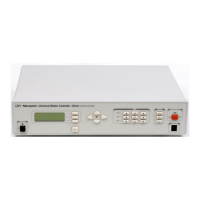HL move group along a line
IMM PGM MIP
USAGE ♦ ♦ ♦
SYNTAX xxHLnn
1
, nn
2
, …nn
i
or xxHL?
PARAMETERS
Description xx [ int ] - group number
nn
1
[ float ] - target position of first axis in a group
nn
2
[ float ] - target position of second axis in a group
nn
i
[ float ] - target position of ith axis in a group, where i can vary
from 1 to 6
Range xx - 1 to MAX GROUPS
nn
i
- any position within the travel limits
Units xx - none
nn
i
- redefined units
Defaults xx missing: error 13, GROUP NUMBER MISSING
out of range: error 14, GROUP NUMBER OUT OF RANGE
not assigned: error 15, GROUP NUMBER NOT ASSIGNED
floating point: truncated
nn
i
Missing parameter: error 21, GROUP PARAMETER MISSING
DESCRIPTION This command initiates motion of a group along a line. It causes all axes
assigned to the group to move with predefined vectorial (tangential) velocity,
acceleration and deceleration along a line. A trapezoid velocity profile is
employed when vectorial jerk is set to zero. Otherwise, an S-curve velocity
profile is employed.
If this command is received while a group move is in progress, the new
command gets enqueued into a “via point” buffer. Please refer Advanced
Capabilities section for a detailed description of via point buffer implementation.
The enqueued commands get executed on a FIFO basis when the move already in
progress has reached its destination. The group does not come to a stop at the
end of last move. Instead, there will be a smooth transition to the new move
command, just as if it were one compound move (combination of multiple
moves).
Note:
The transition from last move to new move will be smooth if tangential velocity
at the end of last move is the same as that at the beginning of new move.
RETURNS If “?” sign takes the place of nn values, this command reports the target positions
of axes assigned to the group.
Section 3 – Remote Mode 3-73

